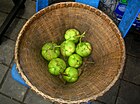Note: This is a project under development. The articles on this wiki are just being initiated and broadly incomplete. You can Help creating new pages.
Difference between revisions of "Dillenia indica - Bhavya"
(→Fruit) |
(→Fruit) |
||
| Line 42: | Line 42: | ||
===Fruit=== | ===Fruit=== | ||
| − | {{Fruit|aggregate of berries|3.5 × 1.5 cm|Globular, covered by overlapping circular scales||seeds 5, 6×4 mm, reniform, compressed, reddish, echinate with hairy margins.}} | + | {{Fruit|aggregate of berries|3.5 × 1.5 cm|Globular, covered by overlapping circular scales|Globular, covered by overlapping circular scales|seeds 5, 6×4 mm, reniform, compressed, reddish, echinate with hairy margins.}} |
===Other features=== | ===Other features=== | ||
Revision as of 12:08, 23 April 2019
Bhavya , Elephant apple is a very ornamental evergreen tree with a rounded crown and large corrugated leaves that can grow up to 30 metres tall, though is usually smaller. The bole can be 120cm in diameter, often branching from low down. The plant provides an edible fruit, polish, soap and medicines for the local people.
Contents
- 1 Uses
- 2 Parts Used
- 3 Chemical Composition
- 4 Common names
- 5 Properties
- 6 Habit
- 7 Identification
- 8 List of Ayurvedic medicine in which the herb is used
- 9 Where to get the saplings
- 10 Mode of Propagation
- 11 How to plant/cultivate
- 12 Commonly seen growing in areas
- 13 Photo Gallery
- 14 References
- 15 External Links
Uses
Cough, Pulp used as shampoo, Bad breath, Improves digestion, Goo for scalp [1]
Parts Used
Chemical Composition
Common names
| Language | Common name |
|---|---|
| Kannada | bettakanagalu, kal tega, naaythaeku |
| Hindi | chalta, girnar |
| Malayalam | punna, syalita, valappunna, valapunna, vazchapunnai |
| Tamil | uvatteku, uvav, kattarali, kurukati |
| Telugu | kalinga, muchiru, peda kalinga, revadi chettu, uppu ponna, uva |
| Marathi | NA |
| Gujarathi | NA |
| Punjabi | NA |
| Kashmiri | NA |
| Sanskrit | bhavya, bhavyam, ruvya, picchila beeja |
| English | Elephant apple |
Properties
Reference: Dravya - Substance, Rasa - Taste, Guna - Qualities, Veerya - Potency, Vipaka - Post-digesion effect, Karma - Pharmacological activity, Prabhava - Therepeutics.
Dravya
Rasa
Madhura (Sweet), Amla (Sour), Kashaya (Astringent)
Guna
Guru(Heavy), Picchila (Slimy)
Veerya
Sheeta (cold)
Vipaka
Madhura (Sweet)
Karma
Vata
Prabhava
Habit
Identification
Leaf
| Kind | Shape | Feature |
|---|---|---|
| Simple | alternate | Petiole 15-75 mm long, stout, sheathing, winged, tomentose, grooved above; lamina 18.5-30 × 5-10 cm, elliptic, oblanceolate, elliptic-oblanceolate or oblong-lanceolate, base cuneate, acute or attenuate, apex acute or acuminate, margin serrate to dentate, glabrous above, strigose or pubescent beneath; lateral nerves many, parallel, prominent, intercostae scalariform, faint. |
Flower
| Type | Size | Color and composition | Stamen | More information |
|---|---|---|---|---|
| Bisexual | Terminal | White | 12-15 cm across, solitary, white, terminal; pedicel 4-8 cm long, silky hairy; bracts to 5 mm long, solitary, median on pedicels, lanceolate; sepals 5, 4-6 × 3-5 cm, obovate, orbicular or elliptic, thick, fleshy; petals 5, 7-9 × 5-6 cm, obovate or oblong, white, veins green; stamens many, cohering slightly at base, in 2 series, outer 13-15 mm long, inner ones 20-22 mm long, inner ones arching over the short outer ones; carpels 14-20, cohering at the axis, ovules many; styles free, 18-25 mm long, flattened, oblanceolate to linear-lanceolate, spreading, white. Pseudocarps yellowish-green, globular with enclosed sepals, 10-12 cm across. |
Fruit
| Type | Size | Mass | Appearance | Seeds | More information |
|---|---|---|---|---|---|
| aggregate of berries | 3.5 × 1.5 cm | Globular, covered by overlapping circular scales | Globular, covered by overlapping circular scales | seeds 5, 6×4 mm, reniform, compressed, reddish, echinate with hairy margins. | {{{6}}} |
Other features
List of Ayurvedic medicine in which the herb is used
Where to get the saplings
Mode of Propagation
How to plant/cultivate
Season to grow
Soil type
Propagation
Commonly seen growing in areas
Tropical area, Sub tropical area
Photo Gallery
References
External Links
- Ayurvedic Herbs known to be helpful to treat Cough
- Ayurvedic Herbs known to be helpful to treat Pulp used as shampoo
- Ayurvedic Herbs known to be helpful to treat Bad breath
- Ayurvedic Herbs known to be helpful to treat Improves digestion
- Ayurvedic Herbs known to be helpful to treat Goo for scalp
- Herbs with Fruits used in medicine
- Herbs with common name in Kannada
- Herbs with common name in Hindi
- Herbs with common name in Malayalam
- Herbs with common name in Tamil
- Herbs with common name in Telugu
- Herbs with common name in Sanskrit
- Herbs with common name in English
- Habit - Tree
- Index of Plants which can be propagated by Seeds
- Index of Plants which can be propagated by Cuttings
- Herbs that are commonly seen in the region of Tropical area
- Herbs that are commonly seen in the region of Sub tropical area
- Herbs
- Plants of western ghats
- Tree






